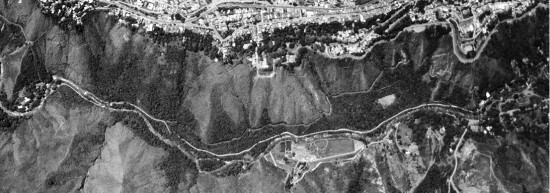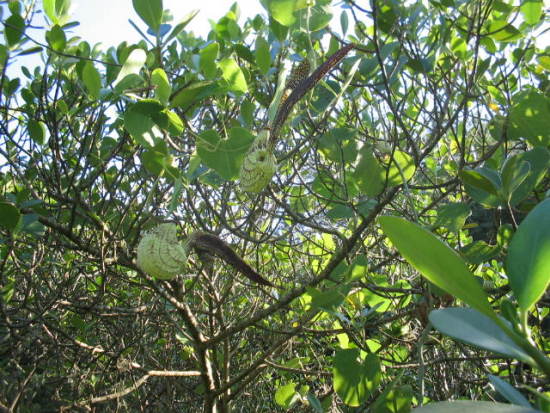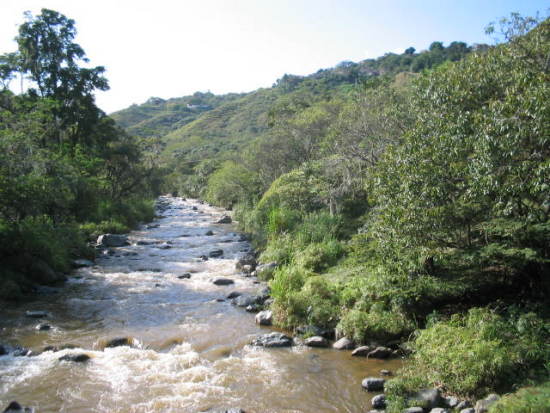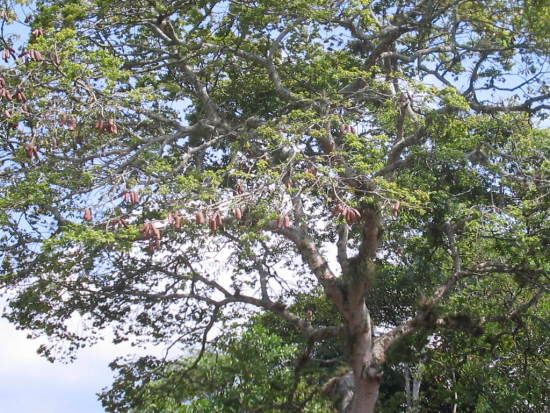Abstract
The Cali Botanical Garden, located in the middle sector of the Cali river basin, is totally covered by vegetation classified as Tropical dry-Forest. The preliminary analysis of its flora shows a marked dominance of about six tree species including Arrayán (Myrcia popayanensis), Laurel Jigua (Cynammomum triplinerve), Sangregao (Croton gossypifolius), Guácimo (Guazuma ulmifolia), Chiminango (Pithecellobium dulce) and Chagualo (Clusia sp). The vegetation of the lower stratum is dominated by herbaceous species of the genus Piper and by members of the Phytolaccaceae and small individuals of the emergent plant species. Among the climbing species the Aristolochia, Passiflora and Cucurbitaceae are noteworthy. The aerial roots of Ficus, Clusia and Sapindaceae are equally numerous. The vegetation present in the CBG became established in an area totally devoid of vegetation in the last 80 years. The area was subjected to cattle ranching and agriculture in addition to recurrent episodes of man-provoked fires. The 50 tree species of the garden constitute a germplasm bank of early successional plants ideal for advancing ecological restoration processes in interandean hillsides. The Garden initiated last year a program to substantially increase the native vegetation cover in the watershed using the reproductive potential of the existing regenerated forest.
Key words: restoration, conservation, systematics, ecological
succession
Resumen
El Jardín Botánico de Cali, ubicado en la cuenca media del río Cali, está cubierto en su totalidad por una vegetación clasificada como Bosque seco-Tropical. El análisis preliminar de su flora indica una dominancia marcada de unas seis especies en los estratos altos entre las que se destacan Arrayán (Myrcia popayanensis,), Laurel Jigua (Cynammomum triplinerve), Sangregao (Croton gossypifolius), Guácimo (Guazuma ulmifolia), Chiminango (Pithecellobium dulce) y Chagualo (Clusia sp). La vegetación del estrato bajo está dominada por Piper spp, Phytolacaceae y plántulas de las especies de estratos superiores. Asociada al bosque hay una profusión de plantas trepadoras y de bejucos. Entre estas especies se destacan las Aristolochiaceae, Passiflorae, y Cucurbitaceae. Vale la pena anotar que la vegetación boscosa, se ha establecido en un área de 12 hectáreas en los últimos 80 años sobre un terreno cuya vegetación fue alterada y removida como consecuencia de ganadería extensiva, incendios forestales y obras civiles. Las cerca de 50 especies arbóreas del JBC constituyen un banco de germoplasma de especies pioneras ideales para adelantar procesos de restauración ecológica en laderas de los valles interandinos.
Palabras clave: restauración, conservación, sistemática vegetal, sucesión
Introduction
The Tropical dry Forest (Bs-T) is a vegetation formation with continuous forest cover between 0-1,000 m in altitude and temperatures above 24º C and average annual rainfall between 700 and 2,000mm, with one or two dry periods per year (Espinal 1985; Murphy & Lugo 1986; Institute von Humboldt 1997). The Bs-T represents about 50% of the forested areas of Central America and 22% of South America (Murphy & Lugo 1986). In Colombia this formation is found in the Caribbean region and in the interandean valleys of the rivers Magdalena and Cauca in an area which presumably covered about 8,146,000 hectares (Espinal & Montenegro 1977).
The Tropical dry Forest is one of the most threatened ecosystems of the Neotropics (Janzen 1987). In Colombia it is one of the most degraded and fragmented, with estimates of present total cover of less than 1.5% of the original cover (Etter 1993). Of this total the greatest proportion is found in the arid pericaribbean belt with more than 6 million hectares and the NorAndean -Chocó-Magdalena province with about one million hectares (Espinal and Montenegro 1977;Hernández et al. 1992). The dry forest of the upper Cauca river valley, the main tributary of the Magdalena river, originally covered about 300,000 hectares in the Department of Valle del Cauca. Presently, the dry forest has practically disappeared to the advance of sugarcane cultivation, the major economic crop of the State. It is estimated that the cover of this formation in the Cauca Valley is less than 3,000 hectares with documented reductions of 66% between 1957 and 1986 (CVC 1994). Only a few forest relicts remain, all below 16 hectares each. The situation is only slightly less dramatic along the piedmont areas of the Central and Western Andean ranges where a few remnants and regenerated forests exist (Figure 1).

Figure 1. Panoramic view of the Cali river basin with Botanic Garden and Commune One.
General
Objective:
The study was undertaken to determine the composition and structure of the vegetation of the Cali Botanical Garden and to develop an education for conservation of biodiversity strategy aimed at the neighboring populations in the city of Cali, Colombia.
Specifically, we set to analyze the species composition and the structure of the vegetation in relation to the development of the forest. Actually, the vegetation described in this project constitutes the living plant collection of the Botanical Garden, since the CBG is a conservation garden. The determination of the potential of the forest remnant of the Cali Botanic Garden to serve as a source of germplasm to undertake restoration processes along the middle sector of the Cali river basin and in Andean hillsides was also a goal of the project. To involve the local communities surrounding the Garden, the project developed an education strategy to familiarize them with the most prominent aspects of the vegetation and the fauna.
Methods
The characterization of the vegetation was developed in three stages: The collection of plants, the identification, and the systematization of the information. The area inventoried covered 8 hectares in which 20 belt transects (50m X 2m) was established. All individuals with DBH ≥ 10 cm were included, following the methodology used by Gentry (1982).
Standard measurements were obtained from each individual plant sampled; DBH, above ground height and canopy cover. A collection of desired specimens was assembled for identification and confirmation by specialists of the herbaria of the Universidad del Valle and State Botanic Garden.
To determine the development stage of the vegetation of the Botanical Garden a comparison was made with photographs of known age of the watershed. The vegetation cover which existed at various times was estimated as the progression of the regeneration process during the past 100 years of history along the Cali river basin. Both the vegetation cover in the hillsides as well as the presence of human infrastructures was established.
The data collected in the field permitted the calculation of relative abundance and cover, species composition and richness. A profile of the vegetation was made along the guidelines of Gonzalez and Devia (1995) in a forest of similar conditions in the piedmont area of the Central Andes in Tuluá, Valle del Cauca.
The presence of many plant species in areas affected by forest fires of known dates and magnitudes in the middle sector of the watershed permitted an initial evaluation of the precocity of establishment and growth in degraded and compacted hillsides
Results
History of the regeneration process:
By 1910, the inauguration date of the first hydro electrical power plant of Cali, the native vegetation had been totally eliminated. A combination of reason explain this forest conversion: large demand of wood charcoal by the 25,000 inhabitants of Cali; removal of native vegetation during the construction of the water conduction channels to the power plants; use of round logs for construction of roads; use of hardwoods for the construction of railroad ties; use of fires to clear land for agriculture and cattle ranching; and dry season natural forest fires. Between 1910 and 1930 the regeneration process was rather slow, even though the water channel and the river provided complete protection from forest fires generated outside and above the water channels to the vegetation undergoing regeneration within the forest. The most vigorous regeneration occurred in the last fifty years, when most homes were using electricity instead of charcoal to cook their meals. The vegetation we see today includes mature trees of 20 meters! The photographic evidence of the watershed also provides evidence that the forest of the Garden is not a recent relict but a vigorous regeneration favored by the water channels and the river which isolated two forest fragments one of 11.5 hectares (now the Botanical Garden) and a 26 hectare plot just a couple of kilometers west of the Garden.
Thus, the forest cover found today in the CBG (and in various places in the basin) is the consequence of vigorous regeneration processes. A continuous secondary succession process has taken place which started in an opened field dominated by grasses with little arboreal vegetation and rather distant sources of plants for colonization more than four kilometers and at least 300 meters of altitudinal difference to the nearest continuous forest patch.
The
species of the Garden:
The species found at the CBG comprise an arrangement of pioneering secondary succession, with level of species richness comparable to those of other dry forests formations in the Cauca River valley (Gonzalez and Devia 1995). The total number of 49 tree species is lower than the average number of 58.1, n= 8 sites) found by Gentry (1995). The forest of the Garden shows a notorious dominance of six tree species which in terms of numbers are ranked as follows: Arrayán (Myrcia popayanensis), Laurel Jigua (Cynammomum triplinerve), Sangregao (Crotón gossypifolius), Guácimo (Guazuma ulmifolia), Chiminango (Pithecellobium dulce) and Chagualo (Clusia sp). The vegetation of the lower stratum is heavily dominated by Cordoncillo (Piper sp) and Anamú (Petiveria alliacea) Phytolacaceae family, (Croton) and individual plants of the dominant middle and upper strata. Associated to the forest there is a profusion of climbing and liana species. Among these species the Aristolochia (two species) (Figure 2), Passiflora (four species) and Cucurbitaceae are noteworthy. The species of medium levels are: Sangregao (Croton) two species), Arrayán (Myrcia), two species), Guava (Psidum guajava), Verraquillo (Trema micrantha), Carbonero (Calliandra pittieri), Jigua (Cynammomum), Guácimo (Guazuma), (Leucaena), Chagualo (Clusia), (Solanum) and (Miconia spp).

Figure 2. One of the dominant species of the Garden is Chagualo (Clusia sp).
The totality of the flora of the botanical garden constitutes a germplasm bank of native pioneering species ideal to advance reforestation processes in the interandean river valleys. About 20-25 tree species were identified as promissory for ecological restoration and enrichment processes along Andean hillsides (Figure 3).

Figure 3. Regenerated gallery forest along the Cali river
The Cali Botanical Garden vegetation
compared with neighboring mature relict forests
In comparisons with other forests found in the Andean piedmont areas of similar size and level of connectivity with other forest fragments the CBG registers slightly lower species richness and the species composition differs in several key species. For example, in the municipality of Jamundi just south of Cali, the Ecological Reserve of Miravalle (CVC unpublished), in the Calichal river (affluent of the Jamundí river), and the piedmont forests along the Rio Claro (Hacienda La Novillera) the dominant species are: Cascarillo (Laderbergia magnifolia), Tumbamaco (Didimopanax morototoni), Niguitos (Miconia spp), Balso (Ochroma lagopus), Ceiba (Ceiba pentandra), Caracolí (Anacardium excelsum), Algarrobo (Hymenaea courbaril), Madroño (Garcinia madruno), Dinde (Maclura tinctoria),Cañafístula (Cassia grandis), Cedro (Cedrella odorata), Samán (Albizzia saman), Orquídea (Catasetum tabulare), Orejero (Enterolobium cyclocarpum), Azulito (Petrea rugosa), Siete-Cueros (Machaerium capote), Guáimaro (Brosimum alicastrum), Caimo (Chrysophyllum argenteum), Guácano (Oxandra espintana), Cámbulo (Erythrina glauca) and (E. poeppigiana), Cachimbo or Pízamo (Erythina), Palma cuesco (Attalea (Scheelea) butyraceae), Rose and Yellow Gauyacanes (Tabebuia rosea) and (T. chrysantha), Totocal (Achatocarpus nigricans) (Figure 4). Although this zone is slightly wetter (1.300 a 1.400 mm) than the Cali river basin (900-1,000mm), the difference in species composition is notorious in the presence of mature tropical dry forest species. The relict forest of the valley floor and the piedmont areas showed a vegetation typical of late stages of the ecological succession.

Figure 4. Algarrobo (Hymenaea courbaril) typical species of mature tropical dry forest
Discussion
The age of continuous regeneration processes is an important factor in the species composition of a secondary forest. The early pioneering species have special competitive and reproductive abilities. Their capacity to establish themselves in harsh conditions is remarkable. This was evidenced in the site where the Cali Botanical Garden is located today. In addition to being good dispersers and colonizers, they are tolerant to difficult climatic and edaphic conditions like solar exposure, scarcity of nutrients, compacted soils. Many species are also tolerant of forest fires or they are opportunistic to take advantage of the bursts of nutrients following the fire events. Additionally, it is the experience of the authors that these species recuperate rapidly after the foraging voracity of Harvester Ants (Atta cephalotes). This relative tolerance or resistance confers them short and medium term advantages over competing plant species. When the species of plants establish themselves in the plot, they benefit directly from the soil improvement the ants bring to the sites. It is noteworthy that the six dominant species in the Garden are also among the species most readily consumed by the ants!
Conclusions
To use the identified pioneer species of the tropical dry forest as ideal germplasm of native species to promote vegetation enrichment and restorative processes in degraded interandean valley floors and hillsides. Only in the Cauca River valley these areas cover in excess of 200,000 hectares.
To enrich the forest of the Cali Botanical garden with species found in nearby relicts of mature tropical dry forest. These enrichments would in a sense mimic advanced stages of secondary regeneration. Nursery trials with these species would be of paramount importance.
To promote the conservation of regenerated forests in all altitudinal levels in the interandean river valleys, particularly where the vegetation cover has been most severely affected by human activities, like in the coffee belt region (1,300-1,700m) and in the sugar cane zone (1,000m). The connexion of these two areas through biological corridors would generate great environmental and socio-economic benefits.
Acknowledgements
The authors wish to thank the following people: Beatriz Bustamante, Silvia Rodríguez, Margarita González and Flor Ortega, all students of the Environmental Administration program of the Universidad Autónoma de Occidente for their assistance with the plant inventory at the Botanical garden. The financial resources were supplied through a research grant from the Universidad Autónoma de Occidente and through the Fondo para la Acción Ambiental and Regional Corporation of Cauca Valley-CVC.
References
CVC. (1994). Comparación de la cobertura de bosques y Humedales entre 1957 y 1986 con delimitación de las comunidades naturales críticas del valle geográfico del Río Cauca. Cali, Informe 90-7. Documento interno. CVC.
CVC, (1999). Informe sobre la vegetación de Parque Miravalle, Jamundí, Valle del Cauca. Regional Development Corporation of Cauca Valley. Unpublished document.
Echeverri, A.M. (2003). El bosque seco tropical, Boletín Semillas 2 y 3. Jardín Botánico de Cali.
Echeverri, A.M., Soto, I.C. & J.E. Orejuela. (2004). Manual de Recursos Interpretativos del Jardín Botánico de Cali. Fundación Jardín Botánico de Cali, Informe al DAGMA
Espinal, L.S. (1985). Geografía ecológica del departamento de Antioquia. Revista de la Facultad Nacional de Agronomía 38 (1): 24-39.
Espinal, L.S. & E. Montenegro. (1977). Formaciones vegetales de Colombia. Instituto Geográfico Agustín Codazzi, Bogotá, pp 201 .
Etter, A. (1993). Diversidad ecosistémica en Colombia hoy. in: Nuestra diversidad biótica Pp 43-61. CEREC & Fundación Alejandro Angel Escobar.
Gentry, A.H. (1982). Patterns of neotropical plant species diversity. Evolutionary Biology 15: 17-18.
Gentry, A.H. (1995). Diversity and floristic composition of neotropical dry forest. in:. Bullock, S., Medina, E. & H.A. Mooney (eds). Tropical deciduous Forest Ecosystems. Pp. 116-194. Cambridge Univ. Press, Cambridge.
González, S. & W. Devia. (1995). Caracterización fisionómica de la flora de un bosque seco secundario en el corregimiento de Mateguadua, Tuluá, Valle. Cespedesia 20(66): 35-63.
Hernández, C., Walschburger, T., Ortiz, R. & A. Hurtado. (1992). Sobre origen y distribución de la biota suramericana y colombiana. in: Halffter, G. (Ed.). Diversidad biológica en Iberoamerica Pp. 55-104. Programa Iberoamericano de Ciencia y Tecnología para el Desarrollo, Instituto de Ecología, Secretaría de Desarrollo, Mexico, D.F., Mexico.
Instituto Alexander von Humboldt, Programa de Inventario de la Biodiversidad, Grupo de Exploraciones y Monitoreo Ambiental GEMA. (1998). El Bosque seco Tropical (Bs-T) en Colombia.
Instituto de Investigaciones de Recursos Biológicos Alexander von Humboldt. (1998). Informe Nacional sobre el Estado de la Biodiversidad en Colombia. Tres tomos. Instituto von Humboldt, Ministerio del Medio Ambiente, Programa de las Naciones Unidas para el Medio Ambiente-PNUMA. Santafé de Bogotá.
Janzen, D.H. (1987). Insect diversity of a Costa Rican dry forest: Why keep it. Biol. Journal of the Linn. Soc. 30: 343-356.
Mahecha, G. & R. Echeverri. (1983). Arboles del Valle del Cauca. Litografía Arco, Bogotá, 208 Pp
Murphy, P.G. & A.E. Lugo (1986). Ecology of tropical dry forest. Annual Review of Ecology and Systematics 17: 67-68 .
Orejuela J.E. (2004). Restauración y aumento de la cobertura vegetal nativa en la cuenca del Río Cali. Convenio Interinstitucional Fondo para la Acción Ambiental-Corporación Autónoma Regional del valle del Cauca y Fundación Jardín Botánico de Cali. Cali, Colombia. Proyecto en curso.